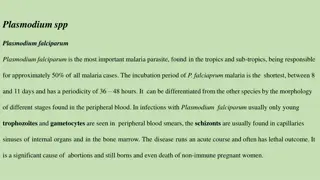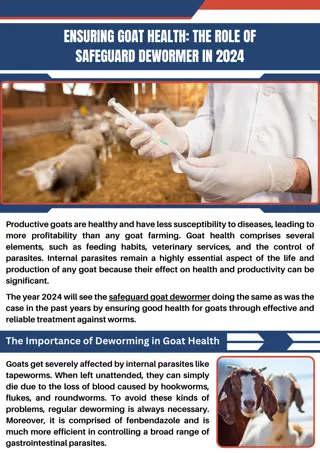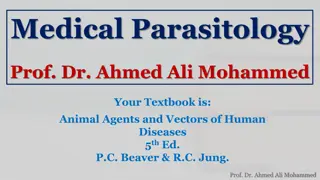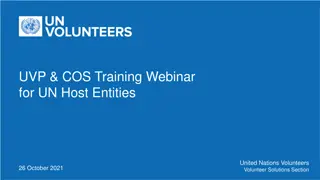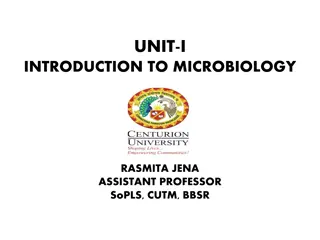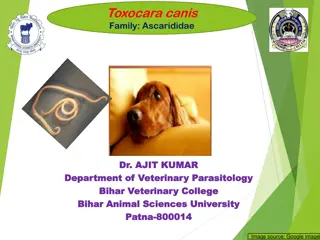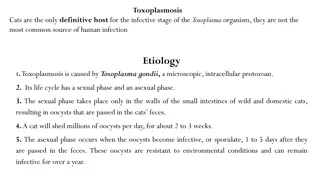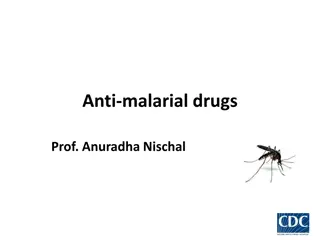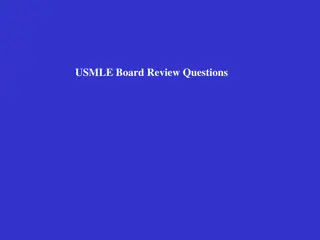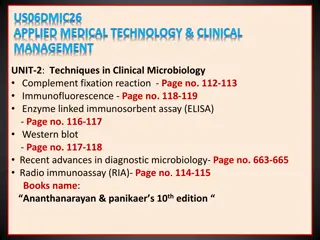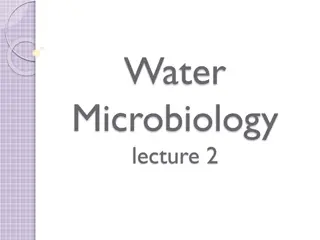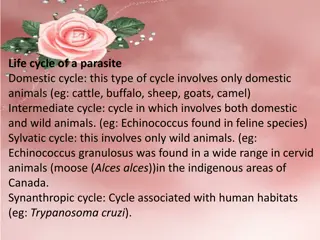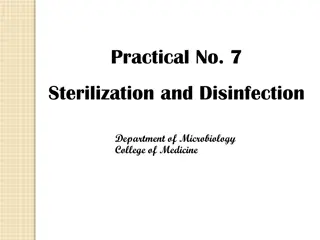Understanding Host-Parasite Relationship in Microbiology
In microbiology, the host-parasite relationship is crucial for understanding diseases caused by pathogens. This lecture covers definitions of terms like pathogenicity, pathogen, disease, resistance, susceptibility, infection, virulence, and transmissibility. It also delves into the division of host resistance, types of pathogens, determinants of pathogenicity, and differentiating between exotoxins and endotoxins. Furthermore, it explores the role of normal flora, primary pathogens, opportunistic pathogens, and examples such as Bordetella species and Mycobacterium tuberculosis in causing diseases. The lecture also touches upon Koch's postulates and the attributes of pathogenicity with relevant examples.
Download Presentation

Please find below an Image/Link to download the presentation.
The content on the website is provided AS IS for your information and personal use only. It may not be sold, licensed, or shared on other websites without obtaining consent from the author. Download presentation by click this link. If you encounter any issues during the download, it is possible that the publisher has removed the file from their server.
E N D
Presentation Transcript
MICROBIOLOGY Lecture : HOST PARASITE RELATIONSHIP IMPORTANT. DOCTORS NOTES. EXTRA INFORMATION.
Objectives Define the terms: -Host-parasite Relationship 3 -Pathogenicity 5 -Pathogen 4 -Disease 5 -Resistance 6 -Susceptibility 6 -Infection 7 -Virulence 7 -Transmissibility 8 1) Know the division of host resistance to parasite. 6 2) Know the division of Pathogens and examples. 3-4 3) Know the determinants of pathogenicity. 5-6-9 4) Differentiate between Exotoxin and Endotoxin 11 5) Recognize the differences between virulence and pathogenicity and know how virulence is measured. 5-7 6) Recognize the transmissibility of pathogens. 8 7) Describe the attributes of pathogenicity and recall examples. 9-12 8) Know about Koch s Postulates 13
Only in this slide : Males slides Females slides Human host is in contact with many microorganisms called normal flora or commensals but only a small number of these microorganism can cause disease and they called opportunistic pathogens and primary pathogens). Host parasite relationship can be discussed under: Host-parasite relationships: is characterized by fighting the organism to invade the body and the body defending itself by protective measures. 1= Primary pathogens : strict pathogens or virulent Bacteria ( ) 2-Non-Pathogenic bacteria:, they will never cause Disease ( ) ------------------------------------------------------------- 1-pathogenicity. 2- normal flora. ) .. ( ( ) ( )
Pathogen Pathogen : a microorganism having the capacity to cause disease in a particular host. Can be divided according to the degree of Pathogenecity into: a) Primary pathogens: -When the organism is able to produce disease even in an apparently healthy host b) Opportunistic (secondary) pathogens: -When the organism causes disease only when the host s defenses are impaired potential pathogens -Cause disease in non- immune host to that organism. e.g. - Bordetella species - Mycobacterium tuberculosis -Having low pathogenicity and infect people with low immunity. e.g. -Pseudomonas
Definitions a)Pathogenicity Ability of Microorganism to cause a disease b)Pathogen A Microorganism having capacity to cause disease in a particular host c)Infectious Disease: End product of an infectious process. .. ..
A Pathogenicity Host Resistance to Parasite Invasion is Divided into: a)Non specific resistance: part of natural constitution of the host.e.g. 1.Competition by normal flora: compete over space and nutrients for example. GIT is relatively rich with normal flora compared to other parts of the body. 2.Skin mechanical barrier 3.Lysozymes 4.Ciliated epithelium of respiratory tract 5.Cough 6.Low pH in the stomach 7.peristalsis(movement of intestines): 8.Neutrophils Disease in the host (just some terminology) Resistance: The ability of the host to prevent establishment of infection by using its defense mechanisms Susceptibility: Lack of this resistance and establishment of disease. b)Specific / Acquired resistance to certain organism: e.g. formation of antibodies
NOTES a)Infection Is simply invasion of cells and multiplication by microorganisms without tissue destruction. b)Virulenceis an ability to Invade and destroy tissue to produce disease (the degree of pathogenicity) Virulence is measured by the Lethal Dose 50 (LD50) LD50: Which is the number of organisms or milligrams of toxins that will kill 50% of susceptible lab animal usually mice when injected into such animal. When the LD50 is small, the microorganism is considered highly virulent and when it is high the organism is said to be of low virulence.
TRANSMISSIBILITY the ability to spread from one host to another. This enables microorganism to maintain continuity of its species in the event of death of original host. ( )
DETERMINANTS OF PATHOGENICITY Before causing disease a microorganism should have the ability to: Adherence (Adhesion, Colonization, Growth) Surviving (escape) the host natural defense mechanisms Multiply to large numbers Invasion Or Toxicity Tissue destruction: It is the ability to overcome host defense invade the tissues and cause destruction to Produce clinical disease = Infectious disease
Adherence: It is the ability to attach firmly to host epithelial surface by the help of pili or other protein surface structures. Structures on host cells include: Fibronectin Proteins and glycopeptide parts media/image4.png Tissue destruction is produced by: Toxin production: Exotoxin Endotoxin(only in tive gram ) Invasion by organisms: Capsulated Non-capsulated
What is the different between exotoxin and endotoxin? Exotoxin gram (+) Endotoxin gram (-) protein Lipopolysaccharide Soluble Part of cell wall Heat Labile Heat stable Non-Specific Low Immunogenicity Pharmacologically specific action High Immunogenicity Inactivated by chemicals to toxoids Do not form toxoids No Fever Induce Fever
CAPSULATED/NON CAPSULATED ORGANISMS Capsulated organisms: bacterial capsules are all made of polysaccharide except of Bacillus anthracis (made of polypeptide). - Capsule prevent phagocytosis : some organisms are readily (easily) killed once they are phagocytized, these organisms called (extracellular organisms) e.g ( pneumococcus ) Non-capsulated organisms: - resist intracellular killing (Phagocytosis) so called (intracellular organisms). - E.g Mycobacterium tuberculosis, Salmonella typhi, Brucella species, The organisms which don t have capsules, have virulence factors to stop phagocytosis ,which is: Exotoxin (toxins): b) A B exotoxins e.g. Cholera toxins a) Membrane active exotoxin e.g. Haemolysin of group A Streptococci A : Active unit B : Binding unit for attachment
KOCHS POSTULATES for a microorganism to be accepted as the cause of an infectious disease it must satisfy all or most of koch s criteria If a microorganism is the causative ( etiologic agent of and infectious disease ) then it must be - Present in every case of the disease, but absent from the healthy host(non infected) - Isolated and grown in pure culture - Able to cause the disease when a pure culture is inoculated into a healthy host - Re-isolated from the host that was inoculated with the pure culture .
quiz A -Which of the following is a secondary pathogen? 1. Bordetella species 2. Pseudomonas 3. Mycrobacterium tuberculosis B-The ability of a microorganism to cause a disease is known as : 1. Pathogen 2. Pathogenicity 3. Infectious disease D-What helps in adhesion on bacterial cells? 1. Mesosomes 2. Flagella 3. pili E-What is a character of endotoxin: 1. Heat liable 2. High immunogenicity 3. Part of cell wall 4. No fever F-What is a character of exotoxin: 1. Soluble and diffusible 2. Do not form toxids 3. Lipopolysaccharide 4. Induce fever C-Which of the following is not a part of Non-specific resisitance: 1. Lysozymes 2. High PH in the stomach 3. Peristalsis 4. ciliated epithelium of respiratory tract G-Lack of resistance and establishment of disease is known as: 1. Susceptibility 2. Resistance 3. Virulence 4. infection
H- Which is the correct statement? I -What is the name of the bacteria the will never cause harm ? 1. When the LD50 is high , the micro organism is considered highly virulent and when it is low The organism is said to be of low virulence 2. When the LD50 is small , the micro organism is considered highly virulent and when it is high The organism is said to be of low virulence 3. When the LD50 is small , the micro organism is considered low virulent and when it is high The organism is said to be of high virulence answers E= 3 BACTERIA. D= 3 I= NON-PATHOGENIC C= 2 H=2 B= 2 G= 1 A= 2 F= 1
THE TEAM : THE TEAM : Contact us : Shrooq Alsomali Hanin Bashaikh Jawaher Alkhayyal Reem Alshathri Rawan Alqahtani Ohoud Abdullah Ghadah Almazrou Lama Al-musallm Waleed Aljamal Ibrahim Fetyani Meshal Eiaidi Khalid Alhusainan Hussam Alkhathlan Faisal Alqumaizi 436microbiologyteam@gmail.com Twitter : @microbio436


